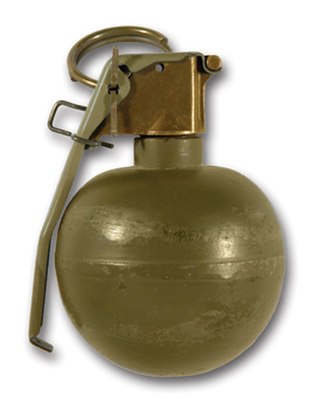 W
WA grenade is an explosive weapon typically thrown by hand, but can also refer to a shell shot out by a rifle or a grenade launcher. A modern hand grenade generally consists of an explosive charge ("filler"), a detonator mechanism, an internal striker to trigger the detonator, and a safety lever secured by a linchpin. The user pulls the safety pin before throwing, and once thrown the safety lever gets released, allowing the striker to trigger a primer that ignites a fuze, which burns down to the detonator and explodes the main charge.
 W
W40 mm grenade is a common design for grenade launcher ammunition. It consists of a low-velocity shell with a caliber of 40 mm (1.57 in).
 W
WAn airburst round is a type of tactical anti-personnel explosive ammunition, typically a shell or grenade, that detonates in midair, causing air burst effect fragment damage to an enemy.
 W
WA blast ball, also known as a tear ball or rubber ball grenade, is a ball-shaped, rubber coated, less-lethal hand grenade designed for police and corrections applications. A blast ball is similar to a traditional "flashbang" grenade in that, when detonated, it generates a loud noise and bright light. In addition, however, a blast ball will also release a chemical irritant, either OC gas or CS gas.
 W
WA grenade is an explosive weapon typically thrown by hand, but can also refer to a shell shot out by a rifle or a grenade launcher. A modern hand grenade generally consists of an explosive charge ("filler"), a detonator mechanism, an internal striker to trigger the detonator, and a safety lever secured by a linchpin. The user pulls the safety pin before throwing, and once thrown the safety lever gets released, allowing the striker to trigger a primer that ignites a fuze, which burns down to the detonator and explodes the main charge.
 W
WFragmentation is the process by which the casing of a projectile from a bomb, barrel bomb, land mine, IED, artillery, mortar, tank gun, or autocannon shell, rocket, missile, grenade, etc. is shattered by the detonation of the explosive filler.
 W
WA grenade launcher is a weapon that fires a specially-designed large-caliber projectile, often with an explosive, smoke or gas warhead. Today, the term generally refers to a class of dedicated firearms firing unitary grenade cartridges. The most common type are man-portable, shoulder-fired weapons issued to individuals, although larger crew-served launchers are issued at higher levels of organisation by military forces.
 W
WA grenade is an explosive weapon typically thrown by hand, but can also refer to a shell shot out by a rifle or a grenade launcher. A modern hand grenade generally consists of an explosive charge ("filler"), a detonator mechanism, an internal striker to trigger the detonator, and a safety lever secured by a linchpin. The user pulls the safety pin before throwing, and once thrown the safety lever gets released, allowing the striker to trigger a primer that ignites a fuze, which burns down to the detonator and explodes the main charge.
 W
WA stun grenade, also known as a flash grenade, flashbang, thunderflash or sound bomb, is a less-lethal explosive device used to temporarily disorient an enemy's senses. It is designed to produce a blinding flash of light of around 7 megacandela (Mcd) and an intensely loud "bang" of greater than 170 decibels (dB). It was first used by the British Army's Special Air Service in the late 1970s.
 W
WThe XM1176 is a high explosive dual purpose grenade designed to be fired by automatic grenade launchers, like the Mk19.